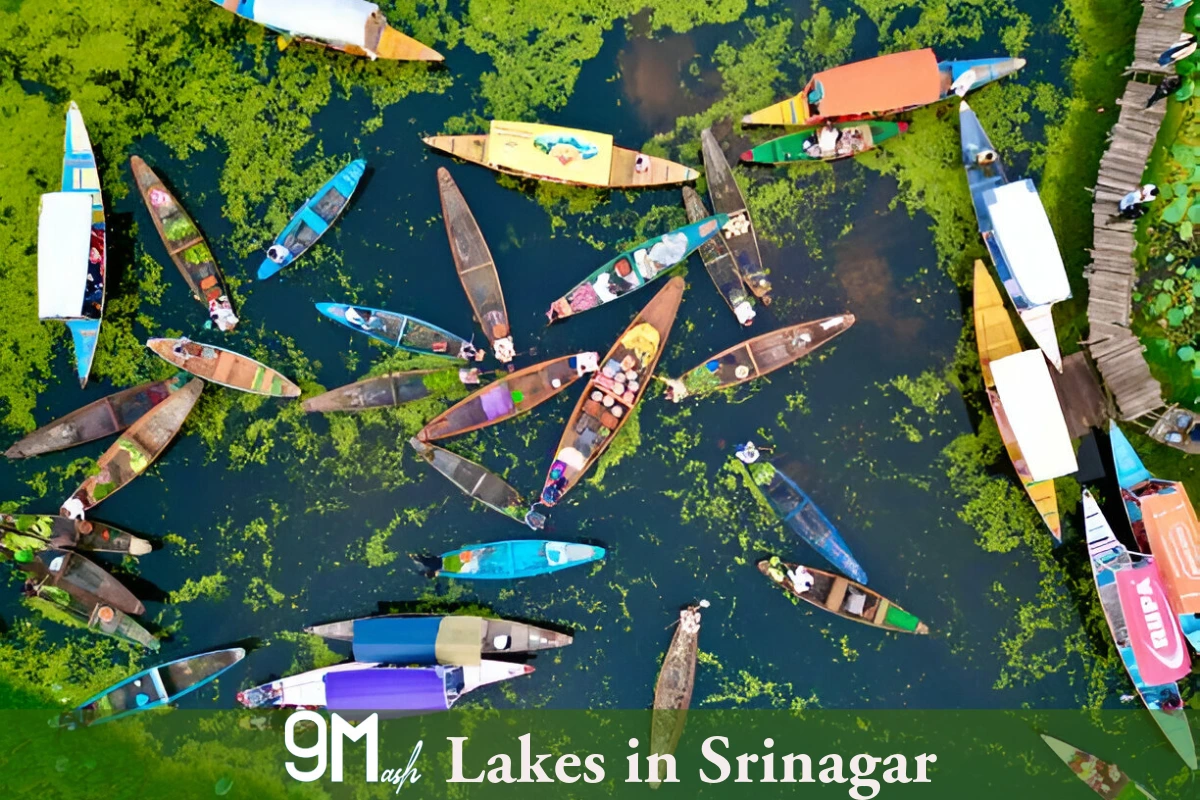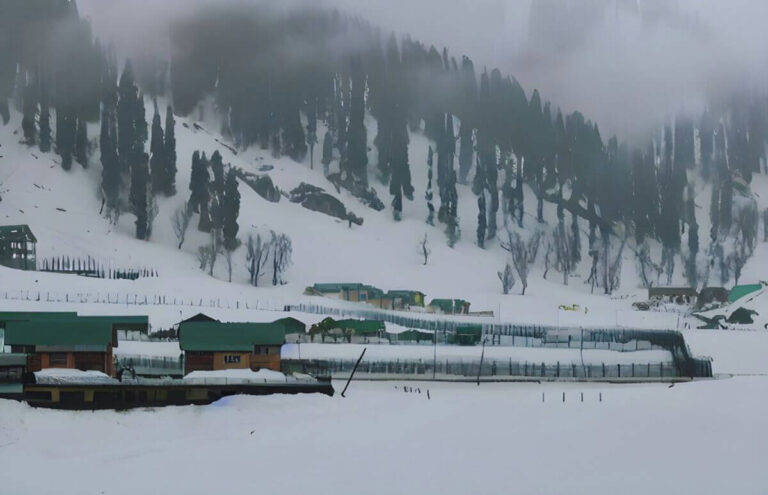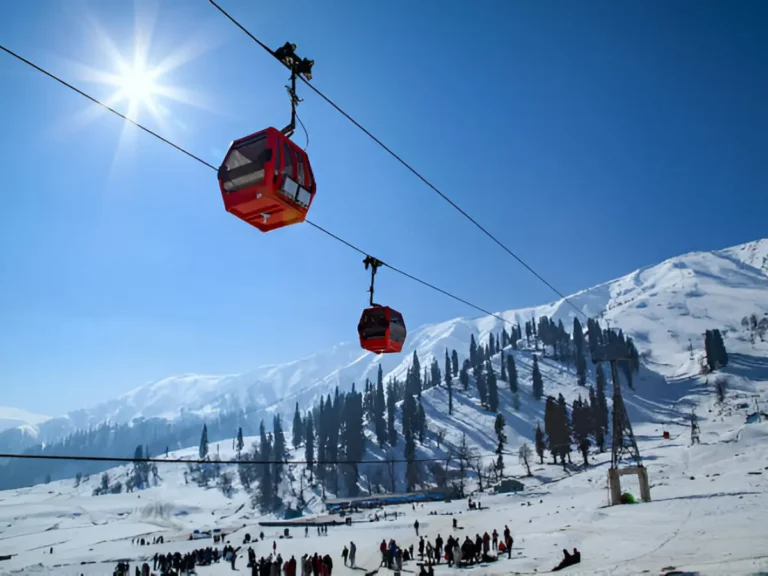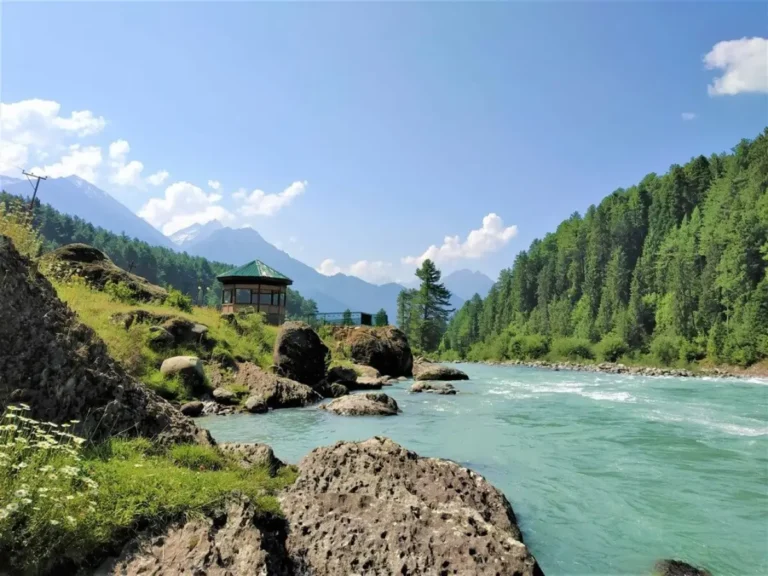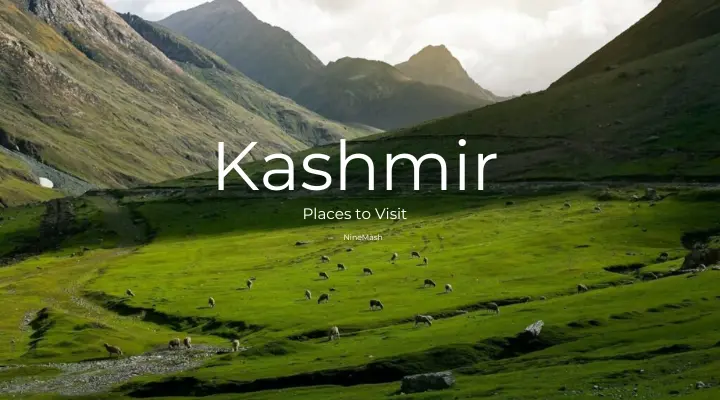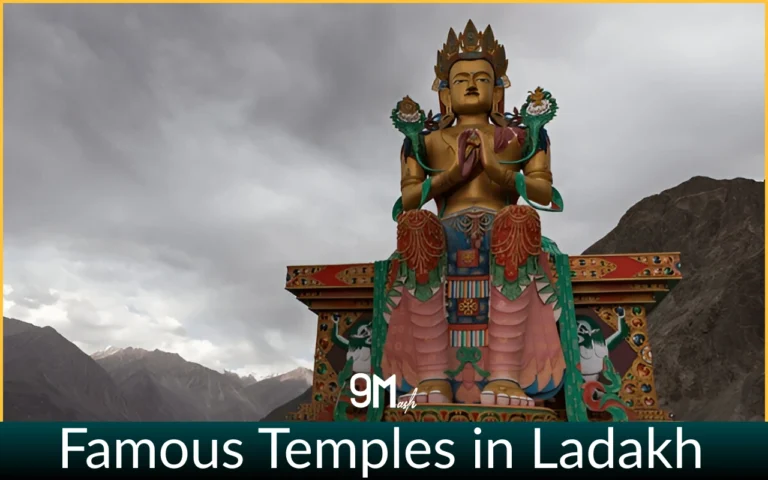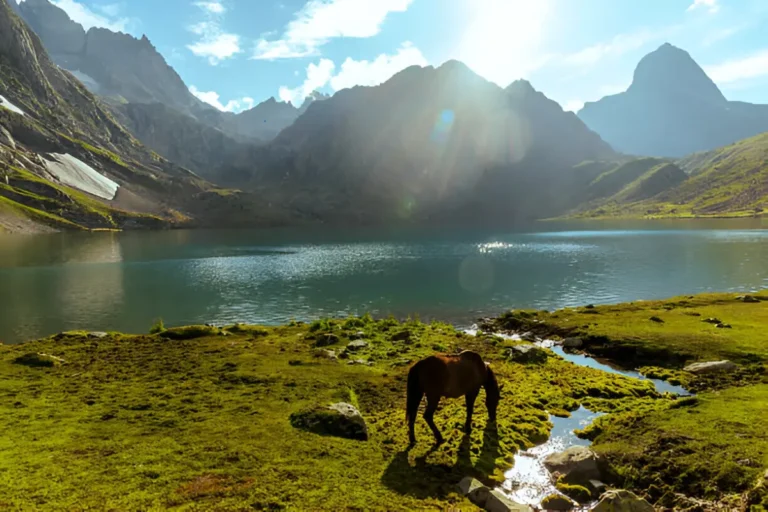7 Famous Lakes in Srinagar to Visit
Srinagar, the summer capital of Jammu and Kashmir, is also known as the city of Lakes. The iconic lakes in Srinagar are not just nature’s marvels but living ecosystems that aid the lives of the local population and draw tourists from across the globe. Therefore, the majority of these lakes are situated in the Srinagar district and are within 15 km of the city. This enables tourists to include the lakes in their itinerary.
These interconnected waterways create a unique aquatic landscape, which has prompted Srinagar to be called the “Venice of the East.” But what I found most unique about the stunning lakes of Srinagar is that these are man-made and also have natural origins.
Additionally, the conventional wooden houseboats, colourful floating markets, migratory birds, and surrounding Mughal architecture offer an unmatched experience. For me, these were not just some natural lakes, but living ecosystems and cultural sites.
However, here are some of the most famous lakes in Srinagar you must visit once you’re there:
- Dal Lake
- Nigeen Lake
- Gil Sar Lake
- Khushal Sar Lake
- Brari Nambal Lake
- Manasbal Lake
- Wular Lake
Below, each of the lakes that are in the Srinagar district is discussed in detail.
1. Dal Lake
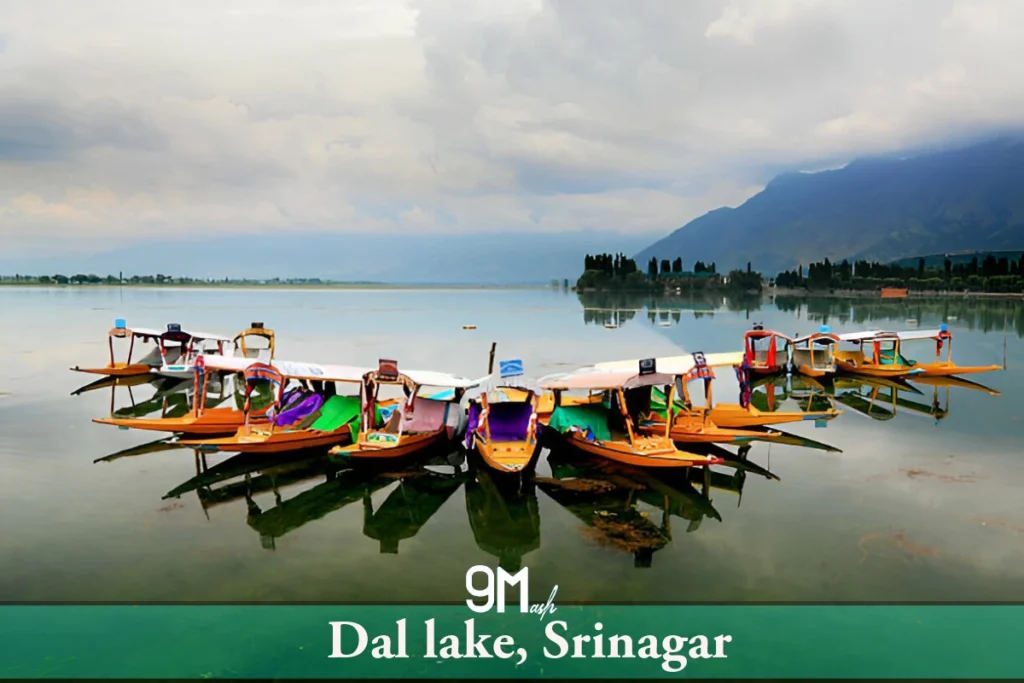
The Dal Lake is called the jewel in Kashmir’s natural crown. This legendary lake lies right in the middle of Srinagar city and is known as the centerpiece of Kashmir tourism. With the striking Himalayan range in the background and clear waters, Dal Lake in Srinagar is a combination of nature at its best and rich culture.
Dal Lake is an urban lake, which is the second largest in the state. It is about 18 km square with a maximum length of 7.44 km and a maximum width of 3.5 km. Its maximum depth is 6 feet, with an average depth of 4.40 feet.
Still confused about what’s attractive about Dal Lake? Well, this lake is significantly divided into four main basins: Gagribal – the lowest in the south, the lesser – often called Lokut Dal, Abod Dal – the largest section, and the Nagin – usually regarded as a separate lake but connected to Dal.
These connected basins form a highly interdependent water system that serves varied human and ecological uses. Overall, Dal Lake is not a small water body but a labyrinth of interlinked waterways, marshes, and floating gardens locally named Rad. Local farmers cultivate veggies, blooms, and fruits on these gardens, a distinct form of farming that has been found here for hundreds of years.
Therefore, tourists visiting Dal Lake can also enjoy a common Shikara water ride with the background of beautiful mountains. These stunning wooden boats are the signature houseboats of Dal Lake, which work both as tourist attractions and water taxis.
However, the Shikara Ride can be had in different forms:
- One-hour scenic trips (₹500-700), highlighting the lake’s beauty
- Sunset rides, experiencing the golden hour on the water on a sundowner.
- Shopping experience at the floating markets
- Full-day trips that visit lakeside gardens and landmarks
Apart from Shikara rides, if you want to explore more, then you can also experience:
- Living in heritage houseboats
- A visit to the floating vegetable markets (which are most active in the early morning)
- Photographs of the lush landscapes.
- Eating on a houseboat at Floating restaurants, sampling local Kashmiri foods
- Water skiing and other water-related activities in the Summer. Regular visitors to the area will recognize these as private river/lake properties.
The Dal Lake is also known for its rich history and culture. It is referred to in the ancient Sanskrit texts as “Mahasarit” and was elaborated upon to a great extent during the period of the Mughal Empire. The local communities have also created special traditions and lifestyles adjusted to live a life on waterways, thus contributing to the cultural heritage of Kashmir.
2. Nigeen Lake
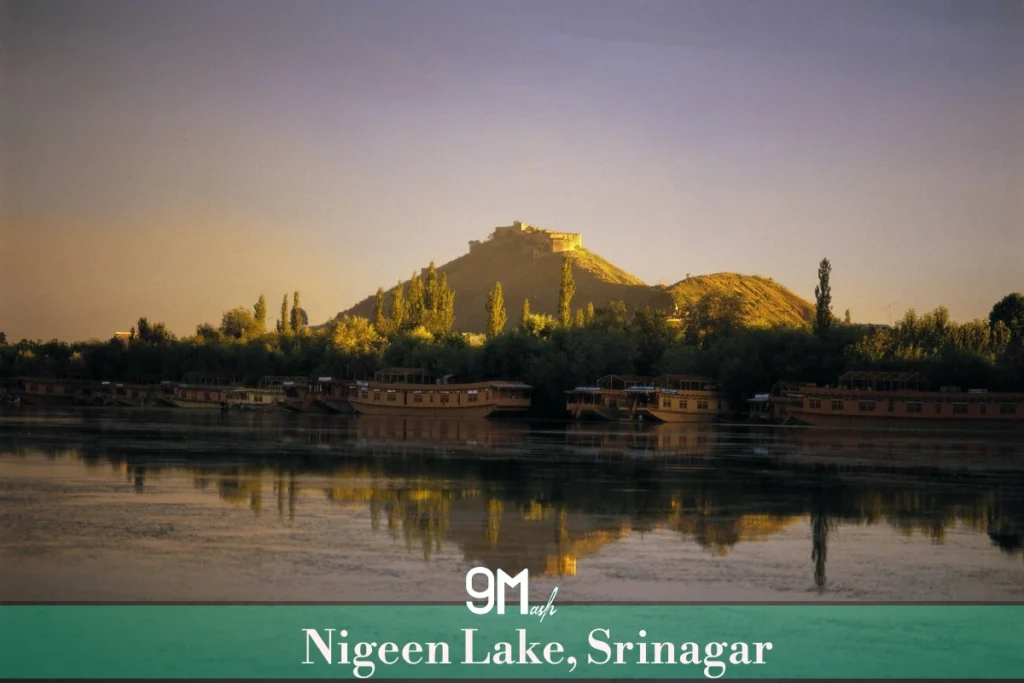
Nigeen Lake is famous for being pristine and calm. This is the quieter and more serene alternative to the busy Dal Lake, offering a peaceful surrounding but taking nothing away from the natural beauty of the place. Nagin Lake lies east of the city, about 8 km from the centre of Srinagar. It is linked with Dal Lake through a causeway.
This lake is part of the same network of lakes and canals that make up Dal Lake and the Jhelum River. Yet its unique characteristics and independent basin have gained it recognition as an independent lake.
How is it? Well, Nigeen Lake is another popular aspect of the lake, and one can just come and enjoy the peaceful environment here rather than dealing with the crowds of the other famous water lakes around. Here you can get a closer experience of Kashmir’s natural beauty, and it is very popular among those looking for peace and unique experiences.
Moreover, the surroundings of the lake are a beautiful scene, all surrounded by a belt of willow and poplar trees. In the backdrop, there are the spectacular Zabarwan Mountains, a perfect setting to click some great pictures! This mix of glittering water, gardens, and mountain views makes Nigeen Lake especially photogenic.
Additionally, you will find traditional wooden Shikaras form the face of Nigeen Lake as they take you peacefully across its silently rippling waters. Houseboats on Nigeen Lake are usually more costly, luxurious, and comfortable than houseboats on Dal Lake, so it is a good choice for accommodation.
Other than cruising, here you can also enjoy:
- Swim (the lake is renowned for its clear waters)
- Bird watching
- Fishing (with proper permits)
- Photography
- Picnicking along the banks
Nigeen Lake is recognised for its relatively pristine waters as compared to Dal Lake and is not as severely crowded as Dal Lake. The depth is a lot more uniform, and it’s much safer for water-based activities. These are then parked along the banks of the river, where tourists can rent them for a night, and will also find some high-end houseboats, restaurants catering to traditional Kashmiri food, and small markets selling local handicrafts and souvenirs.
3. Gil Sar Lake
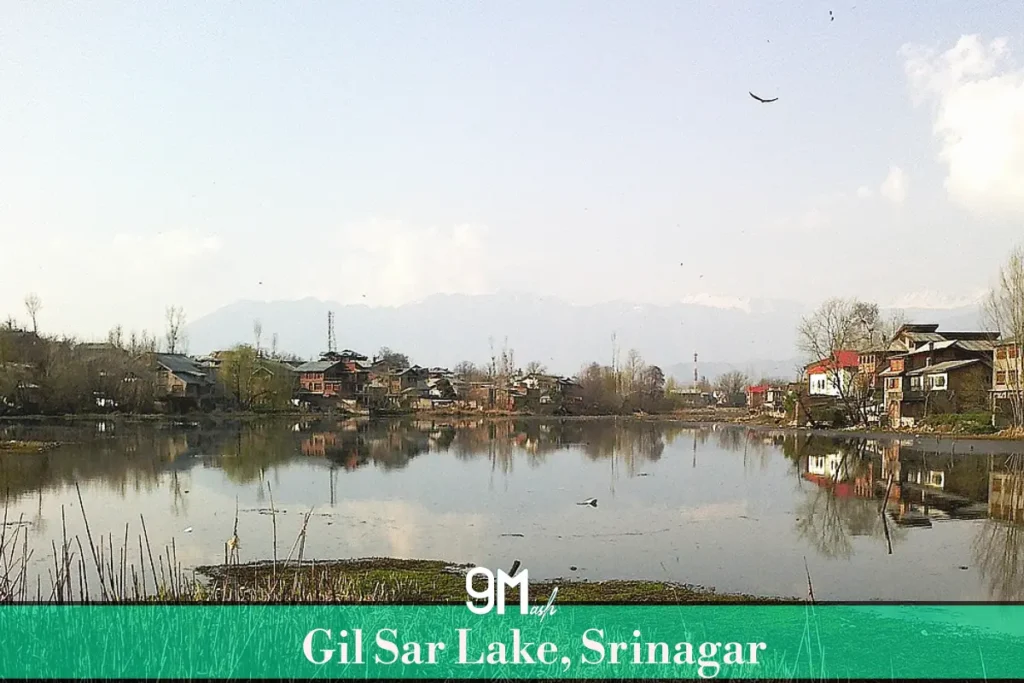
Gil Sar Lake is one of the hidden yet beautiful lakes in Srinagar, which tourists hardly explore. But every time I visited Srinagar, I never missed visiting this lake. It has something unique for m,e and that is the island! This lake is smaller than Dal or Nigeen but also has an island in the centre with floating gardens.
However, the Gil Sar is 2-3m in depth. Its surface area is 0.2 km², with a length of 1 km and a width of 0.5 km. It is situated in the northern area of Srinagar city, not far from the M.A. Road, near Gilsar locality. It’s about 5 km from the city center and can take 15-20 minutes on the road. It is linked via a narrow channel to Khushal Sar Lake as part of Srinagar’s interconnected water network.
Gil Sar Lake is another name as “Gilsar Jheel” and at times it is known as a “Small Mirror Lake” because of its mirror-like reflection. Something worth a visit! At a height of around 1,585 metres (5,200 ft) above sea level, the temperature is cool even in the summer.
One to two hours is the normal period to thoroughly explore Gil Sar Lake. This involves taking a boat ride around its edge and sampling the neighborhood around it. The lake can be comfortably clubbed with a visit to the nearby Khushal Sar Lake for a half-day trip.
4. Khushal Sar Lake
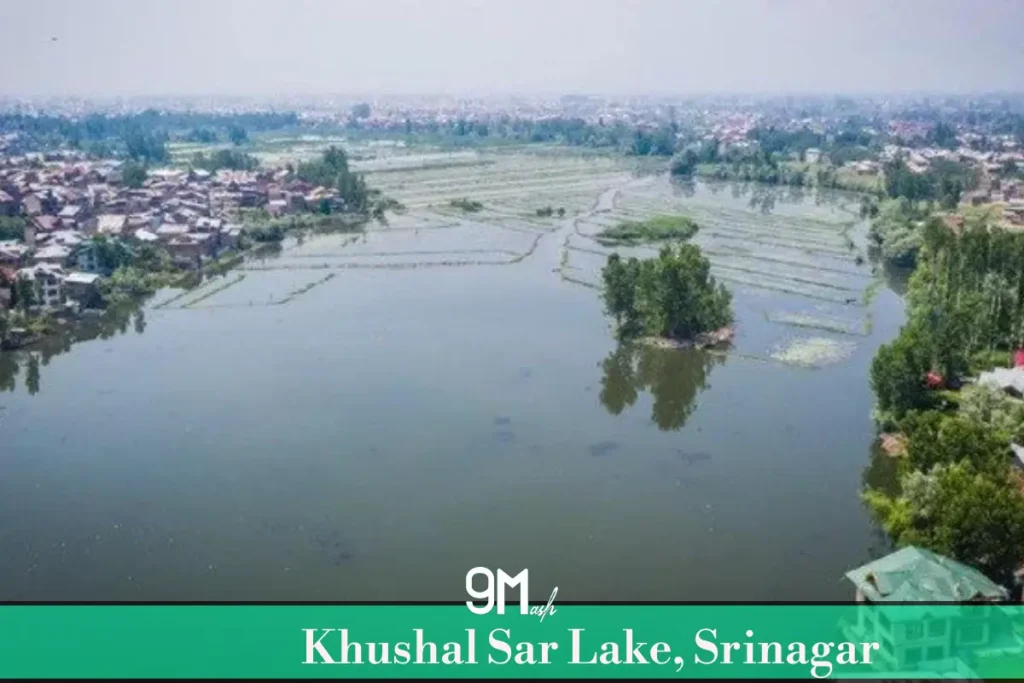
Khushal Sar Lake is also an important facet of Srinagar’s water transport system; however, at present, it is under threat, environmentally. It is about 1-3 meters deep, and varies with the season. This lake covers an area of about 0.5 square km, 1.5 km long and 0.3-0.5 km wide. The size of the lake gets smaller over the years because of encroachment and siltation.
When it comes to the location, the lake is situated between Zoonimar and Aali Masjid in Srinagar and is located at a distance of 4 km from the city centre. It is around 10-15 minutes by road from the city centre of Srinagar. It is also connected to both Gil Sar Lake and Anchar Lake, among other water bodies in the region, which drain into the historic Navigational system of the city.
However, the Khushal Sar Lake had traditionally been a major link in the water transport along the waterways connecting different parts of the city of Srinagar before the influx of modern roads. And usually takes around 1-2 hours to visit Khushal Sar Lake.
Though boat trips are possible, they are less frequent than at the better-known lakes. Others might invest some time in the area to get a glimpse of the less touristy side of Srinagar and learn a little about the city’s historical water systems.
5. Brari Nambal Lake
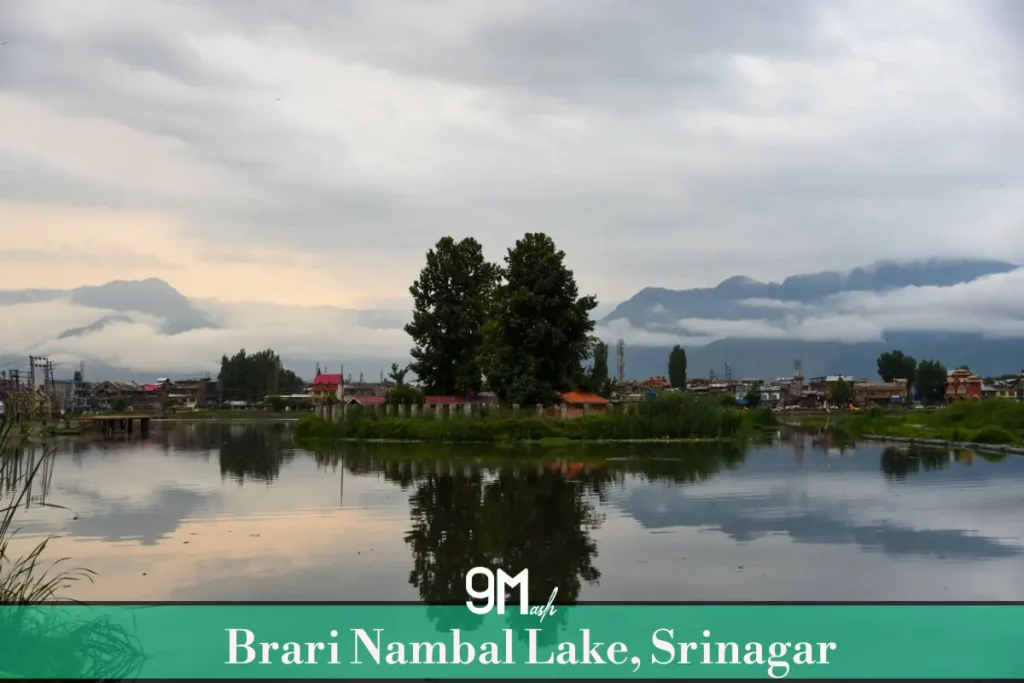
Brari Nambal Lake is one such urban wetland that serves to connect Dal to the Jhelum river, primarily through a complicated network of ample tributaries, providing also a wide range of ecosystem services that have been threatened in recent decades.
This lake is 1-2 meters deep. It is about 0.3 km2 large and 1 km long and 0.3 km wide. The lake, which has been much reduced in size from its historical limits, as a result of drying up and urban expansion, is heavily polluted and eutrophic.
Brari Nambal is situated a few miles away from the city center, in the neighborhood of the famous Lal Chowk district in downtown Srinagar, about 3 km. It is about a 10-minute drive away. Its centrality has been to its advantage when considering accessibility, but it’s also playing a role in the environmental challenges that it is up against.
However, this lake is famously known as “Baba Deemb” to locals. It was historically the major thoroughfare that connected the Dal Lake to the Jhelum River and enabled water transport across the city. BThe rari Nambal Lake visit usually takes around 30 to 60 minutes. Not as photogenic as some of Srinagar’s other lakes due to environmental degradation, it yet offers a significant window on the urban planning dilemmas and conservation efforts facing the region.
Lakes are Not in Srinagar District, But Close to Srinagar
As we already know, Srinagar has many picturesque lakes of its own. Additionally, it is also home to amazing water bodies nearby, which are worth exploring. These aren’t exactly within the Srinagar district, but close enough for a day trip from Srinagar.
Most of them can be reached withina drive of 1-2 hours and will make a perfect entry to your Kashmir itinerary.
We have chosen 2 lakes worth visiting are Manasbal Lake and Wular Lake. The details of these two lakes are discussed below.
6. Manasbal Lake
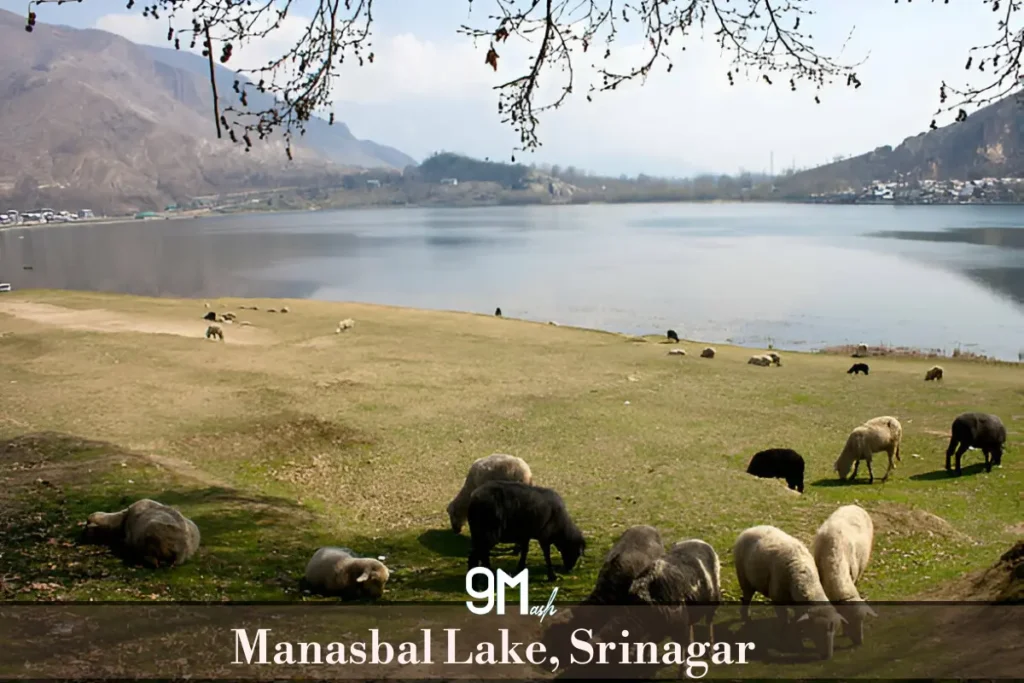
Physical Characteristics
- Depth: can reach up to 13 meters (The deepest lake in Kashmir valley).
- Size: roughly 3.5 km long and 1.5 km wide, with an area of around 2.8 km²
- Height: 1,584 meters above sea level
- Exploring time: 3-4 hours for a whole trip, including a boat tour and a visit to the surrounding site.
Manasbal Lake is located in the Ganderbal district of the state of Jammu and Kashmir in India, north of Srinagar. It is around 1 hour driving and good for a city day trip.
What sets Manasbal Lake’s water inlet apart is that it’s the underground springs that feed it instead of surface streams, which also ensures its extraordinary clarity. According to local belief, the name Manasbal is derived from the name of Lake Manasarovar in Tibet. They also believe that the two are connected by an invisible channel.
The maximum depth of Manasbal Lake is 13 meters. This depth produces an environment that is specifically designed for a wider range of aquatic life. The lake is also widely known for its lotus blossoms, which bloom in July and August and cover the whole lake, making it look like a huge lotus field. The ruins of a Mughal garden named “Garoka” (viewing place), built during the reign of Emperor Jahangir near the northern bank of the lake, provide historical background to the tourists.
Moreover, tourists can view birding, boating, photographing, and picnicking here in the calm environment of the lake. The lake is especially popular among birders since it is a crucial habitat for local and migrating birds, kingfishers, herons, and, once in a while, the few and far between white-tailed eagle.
In addition, the lake, offering some of the best views of the surrounding valley, has many picturesque villages in its vicinity, such as Jarokbal, Kondabal, and Ganderbal, where you can get a taste of rural Kashmiri life. Manasbal Lake lies at coordinates 34°15′N 74°40′E, and it is located to the north of the urban center of Sonawar.
7. Wular Lake
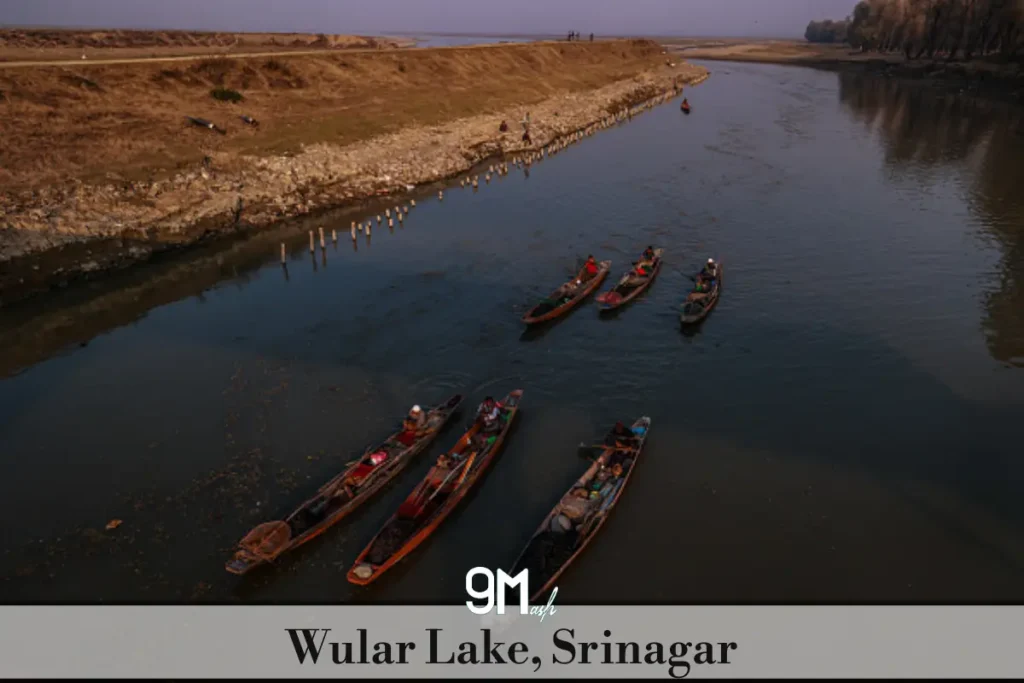
Physical Characteristics
- Depth: can reach up to 13 meters (Deepest lake in Kashmir valley).
- Size: roughly 3.5 km long and 1.5 km wide, with an area of around 2.8 km²
- Height: 1,584 meters above sea level
- Exploring time: 3-4 hours for a whole trip, including a boat tour and a visit to the surrounding site.
Wular Lake is one of Asia’s largest freshwater lakes and a significant natural feature of Kashmir. This huge lake is unlike the more manicured lakes of Srinagar.
It is the main source of the Jhelum River, which acts as the natural flood spill channel for the Jhelum and other rivers of the Kashmir Valley. Zanna Lank, the artificial island created by King Zain-ul-Abidin in 1444, also contributes actual importance to its scenic beauty.
The lake contributes 60% of the fish supply of the Kashmir Valley and sustains the livelihood of more than 8,000 fishermen, who reside in the periphery of the lake.
It has also been listed as a Ramsar site since 1990 for its ecological importance as a feeding ground for migratory birds.
Why Should You Visit Lakes in Srinagar?
Lakes in Srinagar provide a unique and refreshing blend of natural beauty, cultural enjoyment, active pursuits, and local culture that cannot be replicated anywhere else.
Here’s why it’s worth making a splash by adding these water wonders to your travel plans:
- Stunning Nature: First of all, the beauty of the crystal water, mountains around & lush greenery make the landscapes look like they were taken out of a painting. Every lake has its personality and allure.
- Enriched culture: From the traditional shikara ride to staying in a houseboat on the Dal or Nigeen lake, this is a unique way to immerse oneself in the rich culture of Kashmir. The floating markets offer a window into local life that few tourist slums around the world can match.
- Photographic Opportunities: Amateur and professional photographers will love capturing the lakes of Srinagar, home to some of the most stunning morning mist to night sunsets, looking over still waters Full to the brim with wonderful photo-ops.
- Quiet Getaways: Environments of complete peace and serenity, like Nigeen and Manasbal Lake, to relaxing and meditating, away from the madness of day-to-day life.
- Ecological Diversity: All three lakes have distinct ecosystems with a rich variety of plants, flowers, and animals, attracting nature enthusiasts and bird-watchers.
- Historical Evolution: Some of these lakes have evolved from ancient times, possessing historical linkages with ancient civilizations, Mughal emperors, and the development of the characteristic cultural ethos of Kashmir.
- Value for money: A houseboat stay is a one-of-a-kind accommodation. You can experience traditional craftsmanship with contemporary amenities at a price that is generally more affordable than a similar stay at a hotel or resort anywhere else.
Want to know more about other places to visit in Srinagar, Read this article.
Things to Remember While Visiting Lakes in Srinagar
To have a pleasant and responsible visit to Srinagar’s lakes, here are a few key points to take care of, including being mindful of local customs,
Be mindful of local customs
Kashmir comes with its own set of traditions and culture. Dress modestly, particularly when visiting religious sites close to the lakes, and always ask before taking a photo of local people.
Bargaining
It’s OK to haggle over the cost of a boat ride or a souvenir, but remember, tourism is an essential form of economy in many local communities. Look for fair prices, rather than rock-bottom deals.
Weather
Be sure to know what the weather is like when you decide to visit. The gardens are in bloom in spring (April-June), summer (July-September) provides warm weather suitable for water activities, leaves turn gold in autumn (September-November), and in winter (December-February), you can witness not entirely frozen lakes in an eerie kind of beauty.
Safety Guidelines
Only use licensed boat drivers, if life jackets are available, do wear them, and abide by local watersport advice. Before you go: When you are planning your trip, review this week’s coronavirus travel restrictions and the travel advisories for the region you are planning to visit.
Photography Permits
Some places may require professional photography or drone use to obtain special permits. Be aware of current rules and restrictions by checking with local authorities or your hotel.
Health
Take medications that you use regularly from home, drink only bottled water, and have good health insurance for your trip.
Local Guides
Hire local guides who can give you background on the history, culture, and who can show you less frequented viewpoints and experiences around the lakes.

